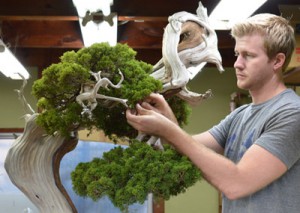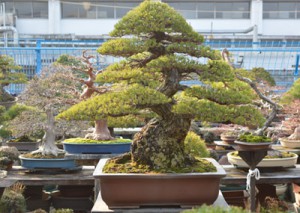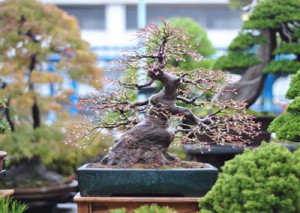Feature
A Love Affair With Bonsai
With a head for business and a heart for bonsai, a young American living in Osaka is earning serious cred in the ancient art of tree training.
 Bjorn Bjorholm wants you to regularly prune your juniper tree by pinching off new buds by hand. Bjorn Bjorholm wants you to strip most foliage from its branches, leaving only flattened “pads” at the tips.
Bjorn Bjorholm wants you to regularly prune your juniper tree by pinching off new buds by hand. Bjorn Bjorholm wants you to strip most foliage from its branches, leaving only flattened “pads” at the tips.
Bjorn Bjorholm wants you to wrap copper wire around these branches before bending them together to create “clouds” of greenery.
Bjorn Bjorholm, in other words, wants you to do bonsai. And if his grand plan goes well, people across all four corners of the globe—and beyond—will be doing the same.
“Everybody I know who is involved with it becomes absolutely obsessed,” says the final year bonsai apprentice and owner of Bjorvala Bonsai Studio. “It takes over your life, but in a good way. I want as many people as possible to experience the same joy that I do. That probably sounds incredibly self absorbed, but I can’t help it.” With the name of a Scandi thriller author and the face of a Hollywood heartthrob, Tennessee-born Bjorholm is not exactly the sort of person you’d expect to be the rising star of the bonsai world. But from a small nursery in Ikeda, the 28-year-old is quietly making a name for himself through his skill at growing miniaturized trees and his passion for teaching this to people around the world. And his distinctly non-Japanese phenotype is a symbol of the seismic shift that’s taking place in this ancient art.
“Bonsai’s time in Japan is waning, but there is huge interest overseas,” he says. “My guess is that there are now more foreign bonsai apprentices than Japanese ones.” By tapping into this burgeoning market, Bjorholm hopes to keep this tradition thriving for generations to come.
How, then, did a man from Knoxville find himself as a crusader of a 1500-year-old Japanese art? It all started, as so many things do, with The Karate Kid. “I saw the movie and just became obsessed,” he remembers. “I bought a tree when I was 13 and killed it, but by then I was hooked.” It wasn’t long before the teenager got himself on a travel abroad program and was on the plane to Mr. Miyagi’s homeland. His host family, after learning of his interest, took him to the Fujikawa Kouka-en nursery where he met the man who would become his mentor and change his life forever.
“When I first met Fujikawa, he was friendly and jokingly said to come back if I wanted to do an apprenticeship,” remembers Bjorholm when meeting the second-generation bonsai nurseryman. Little did the master know that this particular American was in no joking mood. The 16-yearold took Fujikawa’s business card, which he kept for six years. Once at university—where he studied Japanese language and business—Bjorholm started emailing Fujikawa about doing an apprenticeship, only to be met with Miyagi-like sternness. “He said no for a long time,” says Bjorholm. “He was really worried about my language and that I didn’t understand the nature of Japanese apprenticeships being seven-daysa- week, 365-days-a-year. I ended up begging him to take me on just for a three-month trial.” After months of emailing, Fujikawa finally gave in, and Bjorholm was on his way. Fast-forward seven years and the pair have together created a global bonsai brand that is redefining how business is done in this traditionally inward-looking industry. “I noticed that the best bonsai nurseries were very good at marketing themselves,” says Bjorholm, who is also currently completing a PhD in economics at Osaka University. “So I started to wonder how I could make Fujikawa’s name more well-known, since he is among the best, if not the best, bonsai nurseryman in Kansai.” Bjorholm and Fujikawa’s brand is built around education, which they promote through a bilingual website, a video series shot and edited by Bjorholm titled The Bonsai Art of Japan (now it its 43rd episode), social media platforms, and even merchandise like T-shirts.
The crowning glory of all this is the Fujikawa School of Bonsai, created by the pair to provide a bonsai education that is far less formal and time intensive than the usual sixyear apprenticeship.
Now in its fifth year, the school has seen a stream of international students. But interested parties had better book ahead; the school only accepts two pupils for every five teachers on staff.
“This ratio might sound like overkill, but bonsai is an extremely involved art, so this approach allows each student to receive the most in-depth training in the shortest time,” he says.
As part of this education program, Bjorholm frequently travels to the US where he leads small-scale workshops on the east and west coasts. In a few months, after he is finally certified by the Nippon Bonsai Association, he hopes to return to his home in the US, where he will establish his own school and nursery.
For now, though, he lives happily with his wife, Nanxi Chen, a foreign language instructor, in an apartment in a peaceful corner of Mino. To keep the peace at home, he maintains separation between work and family.
“My wife hates bugs and dirt, so I don’t do any bonsai at home,” he says. “And besides, my garden is just big enough to hang a clothesline.”
And as for giving the gift of bonsai to woo prospective wives, Bjorholm advises extreme caution. “Given the amount of work needed to maintain bonsai and keep them alive, it’s not a good idea,” he says, “it’s definitely not like a bouquet of flowers.”
But for skilled gardeners, the rewards are unimaginably rich. This past summer, Bjorholm had the chance to style a 350-year-old Shimpaku Juniper named “Hakuryuu” that’s valued at well over six figures. Being given this rare opportunity was the pinnacle of nearly six years as an apprentice. What, then, was going through his head at the time?
“Honestly, it was ‘Just don’t f**k up’.”
[box]
As for giving the gift of bonsai to woo prospective wives, Bjorholm advises extreme caution… “It’s not a good idea…it’s definitely not like a bouquet of flowers.”
[/box]
盆栽に恋して
ビジネスの頭脳と、盆栽の心を持つ男。大阪在住の若きアメリカ人が、日本の伝統文化を世界に広めている。
文:カーラ・アヴォリオ
ビョーン・ビョーホルムから、皆様へのお願い。松の新芽を手で摘んで、手入れしてください。松葉を剪定して、先端に平らな房状の葉だけを残してください。枝をまとめて銅線を巻いて曲げ、「緑の雲」を作ってください。
つまりビョーン・ビョーホルムは、読者のみなさんに盆栽を始めてもらいたいと願っている。この大計画がうまくいけば、世界の隅々で、多くの人びとが盆栽の魅力に目覚めてくれるだろうと期待している。
「僕が知っている限り、盆栽を始めた人はみな病みつきになります。生涯やめられなくなるかもしれませんが、それでいいのです。できるかぎり多くの人に、同じ喜びを体験して欲しい。まったく自己陶酔のように聞こえるかもしれませんが、僕は本気です」
今年で見習い期間を終え、一人前の盆栽職人になる。すでに自身の仕事場「ビョーバラ・ボンサイ・スタジオ」のオーナーでもある。スカンジナビアのミステリー作家のような名前。ハリウッド映画の恋人役みたいな甘いマスク。テネシー州で生まれた彼は、一見して盆栽界の新星と謳われる人物には見えない。しかしこの28歳のアメリカ人は、池田市の盆栽園で静かにミニチュアの木を育て、その確かな腕前で名を馳せるようになった。盆栽を世界の人々に教えようという情熱も人一倍である。そしてこの明らかに日本人らしかならぬ風貌もまた、伝統芸術に劇的な変化をもたらす象徴なのだ。
「日本では盆栽が衰退しています。でも海外では大きな関心が高まっています。今では日本人の見習いよりも、外国人の見習いのほうが多いくらいではないでしょうか」
自分が世界市場の開拓に乗り出すことで、盆栽の伝統が何世代にも渡って隆盛し続ける。そんな未来を、ビョーホルムは夢見ている。
しかし、いったいどんな風の吹き回しで、ノックスビル出身の男が1500年の歴史を持つ日本美術の救世主になろうと決めたのだろう。最初のきっかけは、映画『ベスト・キッド』 だった。
「映画を見て、すぐに虜になったんです。13歳で木を1本買って、枯らしてしまいました。でもそのときから盆栽の世界に夢中でした」
その数年後、16歳になったビョーホルムは、留学プログラムに参加するために飛行機で海を超えた。行き先は、ベスト・キッドの空手家、宮城健介の祖国である。そしてホームステイ先の家族が、彼の盆栽への関心を知って藤川光華園へと連れていった。 そこで彼は、やがて自分の師匠となり、そ の後の人生を決めることになる人と出会う のである。
 盆栽園の二代目、藤川敬一との邂逅を、ビ ョーホルムは懐かしく振り返る。 「初めて会った藤川先生は気さくな人でし た。『見習いになりたかったら、またおいで よ』と冗談交じりで言ってくれたんです」 しかしこの師匠は、16歳の青年の本気を まだ知る由もなかった。藤川から受け取っ た名刺を、ビョーホルムはその後6年間も 大事に保管する。そして日本語とビジネス を学んでいた大学時代に、Eメールを送っ た。盆栽職人の見習いになるための交渉開 始である。だが藤川敬一の対応は、あの宮 城健介のように厳格だった。メールの交換 は何カ月も続いたという。\
盆栽園の二代目、藤川敬一との邂逅を、ビ ョーホルムは懐かしく振り返る。 「初めて会った藤川先生は気さくな人でし た。『見習いになりたかったら、またおいで よ』と冗談交じりで言ってくれたんです」 しかしこの師匠は、16歳の青年の本気を まだ知る由もなかった。藤川から受け取っ た名刺を、ビョーホルムはその後6年間も 大事に保管する。そして日本語とビジネス を学んでいた大学時代に、Eメールを送っ た。盆栽職人の見習いになるための交渉開 始である。だが藤川敬一の対応は、あの宮 城健介のように厳格だった。メールの交換 は何カ月も続いたという。\
「藤川先生には何度も断わられました。僕 の日本語能力を疑っていて、それに年中無 休で続く日本の奉公制度を理解できない だろうと心配されていたんです。それでも 結局、3カ月の試用期間で教えてもらうこ とになりました」
 藤川はついに根負けし、ビョーホルムは彼 のもとへ向かった。あの弟子入りの日から 7年。いまや2人は、この内向きな伝統産業 を国際的なビジネスに育てるため、力を合 わせてグローバルな盆栽ブランドを作り上 げている。現在、ビョーホルムは盆栽修行 の傍ら、大阪大学の経済学博士過程を修 了間近だ。
藤川はついに根負けし、ビョーホルムは彼 のもとへ向かった。あの弟子入りの日から 7年。いまや2人は、この内向きな伝統産業 を国際的なビジネスに育てるため、力を合 わせてグローバルな盆栽ブランドを作り上 げている。現在、ビョーホルムは盆栽修行 の傍ら、大阪大学の経済学博士過程を修 了間近だ。
「いい盆栽園は、マーケティングがとても 上手だと気づいたんです。藤川先生をもっ と有名にするにはどうしたらいいか考えま した。関西の盆栽園でも指折りの実力が ありますから」
ビョーホルムと藤川が作った新しい盆 栽ブランドは、教育的な目的を帯びて いた。バイリンガルのウェブサイト、ビ ョーホルムが撮影と編集を担当したビ デオシリーズ「日本の盆栽芸術」(現 在第43回)、ソーシャルメディア、さら にはTシャツなどの商材によってプロ ーモーションをおこなっている。しかし何よ りも画期的なのは、2人で作った藤川盆栽 学校だ。通常は6年間もかかる見習い修行 よりずっと手軽に、時間も凝縮したカリキュ ラムで盆栽を教えてくれる。
設立5年目の盆栽学校には、外国からの生 徒も続々とやってくるようになった。だが この盆栽学校は、5人の教師に対して2人 の生徒しか受け入れないという狭き門で もある。
「いくらなんでも極端な割合だと思われる かもしれません。でも盆栽は本当に複雑な 芸術なので、この人数でようやく生徒が短 期間ながら徹底的な訓練を受けることがで きるんです」
教育プログラムの一環として、ビョーホル ムは頻繁に米国を訪ねている。小規模なワ ークショップを、東海岸や西海岸で開催す るのだ。あと数カ月で日本盆栽協会から正 式に免許皆伝となったら、ゆくゆくは米国の 生まれ故郷に帰り、そこで自分の盆栽学校 と盆栽園を設立したいと願っている。
だがまだ現在は、外国語講師のナンシー・チ ェン夫人と閑静な箕面市のアパートに住ん でいる。家庭の平穏を守るため、仕事と家 庭はきっちり分けているのだという。 「妻は虫や土が嫌いなんです。だから家で は盆栽をやりません。それにうちの庭は、洗 濯物をようやく干せるだけの広さしかあり ませんから」
自慢の盆栽をプレゼントして、求婚するの も素敵なことだろう。だがそんな案は即座 に却下された。
「盆栽を手入れするのに必要な手間を考 えたら、それはいい考えじゃありませんね。 花束とはだいぶワケが違いますから」 それでも長い訓練が実って、昨年の夏には 予想外の名誉に浴した。樹齢350年、時価 数千万円という真柏松の剪定が、ビョーホ ルムのもとに舞い込んだのである。6年間 の見習い期間で、まさに最高の瞬間。彼の 頭にはどんな思いが去来したのだろうか。 「ヤバい、しくじったら終わりだぞって。正 直言って、ビビりましたね」













